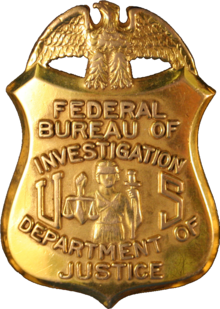FBI Criminal, Cyber, Response, and Services Branch
The Criminal, Cyber, Response, and Services Branch (CCRSB) is a service within the Federal Bureau of Investigation (FBI). Created in 2002 as part of the U.S. government's post-9/11 response, the CCRSB is responsible for investigating financial crime, white-collar crime, violent crime, organized crime, public corruption, violations of individual civil rights, and drug-related crime. In addition, the Branch also oversees all computer-based crime related to counterterrorism, counterintelligence, and criminal threats against the United States.[2]
| Federal Bureau of Investigation | |
|---|---|
 | |
 Badge of the Federal Bureau of Investigation | |
 | |
| Common name | Federal Bureau of Investigation |
| Abbreviation | FBI |
| Motto | Fidelity, Bravery, Integrity |
| Agency overview | |
| Formed | July 26, 1908 |
| Employees | 35,104[1] (October 31, 2014) |
| Annual budget | US$8.3 billion (FY 2014)[1] |
| Jurisdictional structure | |
| Federal agency (Operations jurisdiction) | United States |
| Operations jurisdiction | United States |
| Legal jurisdiction | As per operations jurisdiction |
| Governing body | U.S. Department of Justice |
| Constituting instrument | |
| General nature | |
| Operational structure | |
| Headquarters | J. Edgar Hoover Building Northwest, Washington, D.C. |
| Sworn members | 13,260 (October 31, 2014)[1] |
| Unsworn members | 18,306 (October 31, 2014)[1] |
| Agency executives |
|
| Child agencies |
|
| Major units | 5
|
| Field offices | 56 (List of FBI Field Offices) |
| Notables | |
| People |
|
| Programs | |
| Significant Operations | |
| Website | |
| www | |
Operation
The CCRSB deploys FBI agents, analysts, and computer scientists and uses traditional investigative techniques such as sources and wiretaps, surveillance, and forensics. CCRSB works in conjunction with other federal, state, and regional agencies from 56 field offices and at the National Cyber Investigative Joint Task Force (NCIJTF).[3]
CCRSB operates a 24-hour cyber command center (CyWatch) where they combine the resources of the FBI and NCIJTF. In the event of a significant cyber intrusion, they provide connectivity to Federal cyber centers, government agencies, FBI field offices, legal attachés, and the private sector. They also exchange information about cyber threats with the private sector through partnerships such as the Domestic Security Alliance Council, InfraGard, and the National Cyber Forensics and Training Alliance (NCFTA).[3]
CCRSB maintains overseas legal attaché offices to coordinate cyber investigations and address jurisdictional hurdles and differences in law with other countries while collaborating with cyber crime centers at Interpol and Europol.[3]
The unit also maintains a website called Cyber Shield Alliance (www.leo.gov) which provides access to cyber training and information for the public, and the means to report cyber incidents to the FBI.[3]
The FBI reports that since 2002, they have seen an 80 percent increase in the number of computer intrusion investigations.[3]
Leadership
Headed by an FBI Executive Assistant Director, the CCRSB is responsible to the FBI Director through the Deputy Director.
The current CCRSB Executive Assistant Director is Terry Wade.[4]
Organization
The CCRSB was formed by the unification of the FBI's various traditional crime fighting units.
- FBI Criminal Investigative Division
- FBI Cyber Division
- FBI Critical Incident Response Group
- FBI International Operations Division
- FBI Victim Services Division
Future
It is speculated that the establishment of a National Security Branch and more traditional Criminal Investigations Branch within the FBI this will lead to the formation of "career paths" for FBI Special Agents; meaning that once a new agent has completed Special Agent Training at FBI Academy in Quantico, Virginia, and has completed the mandatory probationary period, that he or she will choose to go into the National Security Branch, or go into the "Criminal" part of the Bureau and focus on crimes such as organized crime, narcotics, civil rights violations, fraud, and violent crime. Some advocates of this new program say that this re-organization will help the fight against terrorism by making it less bureaucratic.
References
- "Frequently Asked Questions". Federal Bureau of Investigation. Retrieved 2016-09-02.
- "Ten Years After: The FBI Since 9/11". FBI.gov. Federal Bureau of Investigation. Retrieved 20 November 2014.
- Anderson, Jr, Robert. "Cybersecurity, Terrorism, and Beyond: Addressing Evolving Threats to the Homeland". Homeland Security & Governmental Affairs. U.S. Senate, 113th Congress, Second Session. Retrieved 20 November 2014.
- https://www.fbi.gov/about/leadership-and-structure